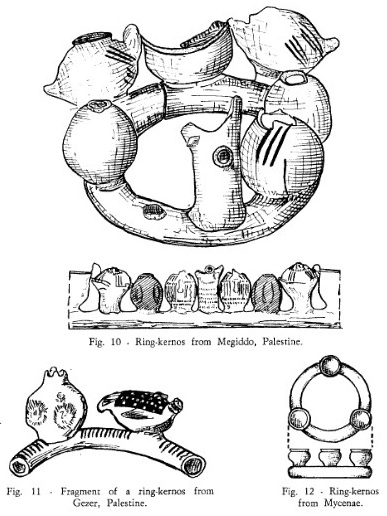Kernos

The form begins in the Neolithic in stone, in the earliest stages of the Minoan civilization, around 3,000 BC. They were produced in Minoan and Cycladic pottery, being the most elaborate shape in the latter, and right through ancient Greek pottery. The Duenos Inscription, one of the earliest known Old Latin texts, variously dated from the 7th to the 5th century BC, is inscribed round a kernos of three linked pots, of an Etruscan type.
The Greek term is sometimes applied to similar compound vessels from other cultures found in the Mediterranean, the Levant, Mesopotamia, and South Asia.
Athenaeus preserves an ancient description of the kernos as: a
terracotta vessel with many little bowls stuck on to it. In them there
is sage, white poppy heads, wheat, barley, peas(?), vetches(?), pulse,
lentils, beans, spelt(?), oats, cakes of compressed fruit, honey, olive
oil, wine, milk, and unwashed sheep's wool. When one has carried this
vessel, like a liknophoros, he tastes of the contents. The kernos was
carried in procession at the Eleusinian Mysteries atop the head of a
priestess, as can be found depicted in art. A lamp was sometimes placed
in the middle of a stationary kernos.
ReferencesAmiran, R.
Ancient Pottery of the Holy Land From its Beginning in the Neolithic Period to the End of the Iron Age. (
New Brunswick, NJ, 1970), pp. 302 - 306.
Pande, B. "Harappan Ring-Kernoi: A Study" in
East and West, Vol. 21, No. 3/4 (September-December 1971), pp. 311-323.
Available Online



